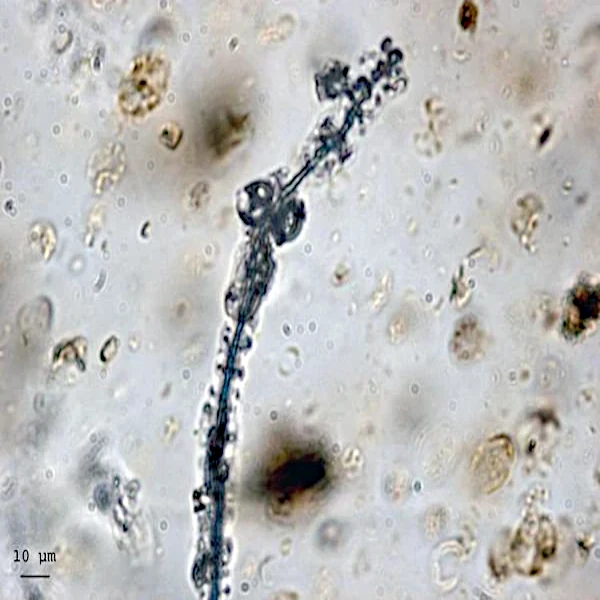
At midnight, the formation of the Earth begins through the gravitational accretion of dust and planetesimals from the protoplanetary disk around the young Sun. This period is marked by intense asteroid bombardment. A major impact with a Mars-sized body, Theia, ejects a large amount of material that will form the Moon. The Earth becomes a molten planet, with iron sinking to the center to form the core.
The Earth begins to structure itself with the separation of layers: a dense metallic core, a viscous silicate mantle, and a primitive crust. This thermal differentiation generates an internal magnetic field, essential for retaining an atmosphere. Intense volcanism releases gases forming a primitive atmosphere rich in water vapor, CO₂, NH₃, and methane.
The surface temperature drops below 100°C, allowing the liquefaction of water vapor. The first oceans form, possibly supplemented by contributions from ice-rich comets. Liquid water covers a large part of the planet within the first few hundred million years, profoundly altering the thermal and chemical interactions of the surface.
In the warm, shallow oceans, prebiotic chemistry gives rise to life. Complex organic molecules, particularly nucleic acids and proteins, self-assemble into membrane structures: protocells. Fossil stromatolites from Western Australia, dated to 3.5 Ga, attest to the presence of photosynthetic cyanobacteria.
The first prokaryotes diversify: some develop fermentation, others use electron donors such as sulfur or iron. The anoxic ecosystems of the ocean depths become prolific biochemical laboratories. This period is marked by a slow accumulation of microbial biomass in marine sediments.
At noon, oxygenic photosynthesis becomes dominant: cyanobacteria release dioxygen ($\text{O}_2$) into the water, then into the atmosphere. Dissolved iron in the oceans precipitates as oxides, forming the famous BIF (banded iron formations). This process marks a major transition, causing the extinction of anaerobic species and laying the foundation for an oxidizing atmosphere.
Around 14h30, the Earth experiences several extreme glacial episodes called "Snowball Earth," during which ice reaches the equator. These events, linked to a drop in atmospheric CO₂ and positive climate feedbacks, cause mass extinctions but also major evolutionary restructuring.
Eukaryotic cells, larger and more complex than prokaryotes, appear through endosymbiosis: some cells integrate bacteria capable of respiration (ancestors of mitochondria) or photosynthesis (ancestors of chloroplasts). This innovation paves the way for increased cellular complexity, sexuality, and later multicellularity.
The first multicellular organisms appear, favoring cell specialization and biological cooperation. These life forms remain aquatic, primarily algal. Intercellular communication and genetic regulation allow for more sophisticated morphological organization. This is the first major step towards complex life forms.
Diversified multicellular life emerges in shallow seas, with soft-bodied organisms like Charnia or Dickinsonia. These enigmatic life forms testify to an ecological transition: proliferation of species, new feeding strategies, and complex trophic interactions. This prelude to the Cambrian explosion reflects rapid evolution of the biosphere.
In 30 minutes, animal diversity explodes: the first arthropods, mollusks, cnidarians, and chordates appear. Mineralized skeletons facilitate fossilization, making this period richly documented. This evolutionary boom marks the beginning of the Phanerozoic, where life becomes visible on a geological scale.
Plants, then arthropods, colonize terrestrial environments. Soils form gradually through the action of roots, promoting geochemical exchanges between the biosphere and lithosphere. The first terrestrial vertebrates, ancestors of amphibians, appear shortly after. Atmospheric oxygen reaches levels conducive to active cellular respiration.
The Earth is covered in vast forests of lycopods and giant ferns. The $\text{O}_2$ level exceeds 30%, allowing the growth of gigantic insects. Reptiles appear, independent of water for reproduction thanks to the amniotic egg. This physiological innovation will be fundamental for future dinosaurs and mammals.
At 23h, the reign of dinosaurs begins on the supercontinent Pangaea. The Triassic, Jurassic, and Cretaceous periods see a major diversification of reptiles, the first birds, and flowering plants. Pangaea begins to fragment, triggering active tectonics and global climatic redistribution.
A 10 km diameter meteorite strikes the Yucatán. The impact raises billions of tons of dust and sulfate aerosols, blocking solar light and causing a collapse of food chains. Non-avian dinosaurs disappear, opening an evolutionary niche that mammals will exploit.
In just 20 minutes, mammals diversify rapidly: insectivores, rodents, carnivores, and primates colonize different ecosystems. The rise of angiosperms transforms terrestrial habitats. The current continents take shape, modifying the distribution of species through continental drift.
Only 1 minute 17 seconds remain on the Earth clock when the first Homo sapiens emerge in Africa. With highly developed brains and articulate language, they create complex tools, organize hunting, develop parietal art, and gradually conquer all continents.
In the last second, humanity enters the Anthropocene. Steam engines, electricity, computers, modern medicine, space exploration: in a geological instant, our species profoundly alters the atmosphere, biogeochemical cycles, and biodiversity. The question remains: how many seconds will we last on this clock?